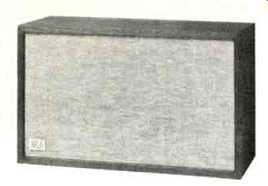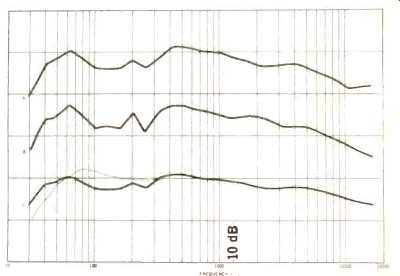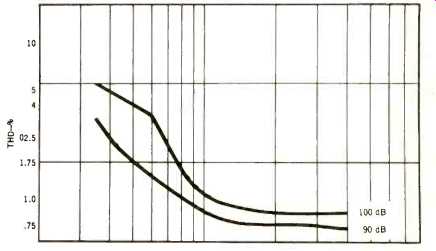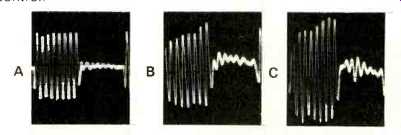
MANUFACTURER'S SPECIFICATIONS
Speakers: Two; 8-in. woofer, with 56 Hz resonance in system, and 1 1/2-in. diameter cone tweeter.
Enclosure Type: Acoustic Suspension.
Crossover Frequency: 1,500 Hz.
Impedance: 8 ohms.
Size: 19 1/2 in. W. x 1 2 in. D. x 7 in. H.
Weight: 20 lbs.
Price: $81.00.
Acoustic Research's Model AR-6 has deceptively similar specifications to the AR-4x. Both are two-way systems, having 8-in. woofers, crossover between 1 and 2 KHz, and their enclosures have virtually the same volume.
Dimensions of the AR-6 are 19 1/2 by 12 by 7 in., and thus it is one of the few bookshelf loudspeakers truly deserving the name. These proportions, besides being practical, are aesthetically more pleasing as well. It is supplied with instructions for hanging and fusing, as well as hook eyes and feet pads.
The tweeter uses the magnet structure of the AR-4x but it has a cone diameter of 1.5-in. instead of 2.5 in. A 5/8-in. dome is in its center with a viscous damped voice coil behind. See Fig. 1.

Fig. 1--Front view of the speaker elements, with the grille removed. Note the
relative sizes of the drivers.
We compared the AR-6 and the AR-4x speakers with a variety of program material and the AR-6 quickly established itself as the superior speaker. This is not to say that the AR-4x is not any less of a bargain at $63.00, but to our ears, the additional $18.00 that the AR-6 costs is clearly audible.
The greatest improvement is in the performance of the 1.5 in. tweeter. Better dispersion, coupled with smoother and wider response, are responsible for the spacious stereo image. Woofer response is good down to 40 or 50 Hz with very little harmonic distortion, a hallmark of all AR speakers.
After our listening tests, we went to the more objective measurement procedure. System input consisted of 1/3 octave pink noise at 1.6 volt. This gave 84 dB S.P.L. at 40 in. on-axis, high frequency control set at maximum.
Figure 2 shows the system's frequency response. The dotted line is speaker response minus room interference. The most notable feature of Fig. 2C, which incidentally is most representative of what a listener will hear, is its unusual smoothness and excellent high frequency power response.
The lack of harmonic distortion, even at levels in excess of 100 dB, was equally gratifying. See Fig. 3.
Impedance stayed close to its rated 8 ohm value, and with the high frequency control at normal, never went below 6.75 ohms, as shown in Fig. 4. At maximum setting of the high frequency control, the impedance dipped briefly to 5 ohms at 8,000 Hz-still quite safe for any decent amplifier, but an unlikely balance setting for all but a Victorian living room.
Tone burst response, as shown in Fig. 5, reveals excellent transient response at all test frequencies. Efficiency was what one would expect from an acoustic suspension loudspeaker, medium to low. Twenty to 40 watts is sufficient power to drive this speaker system, depending on one's musical taste.
After listening to the AR-6 on and off during a three-week period and comparing it with its biggest brother, the AR-3a, we had no reason to change our initial high opinion of it. We predict that the AR-6 will supplant the AR-4x on the best seller list and probably establish itself as the standard for other loudspeakers in the under-$100.00 class.
--Alex Rosner

Fig. 2--Frequency response of the AR-6 loudspeaker to 1/3-octave pink noise,
A, on-axis; B, 45 degrees off axis, and C, average of five readings. The
dotted line compensates for room interferences.

Fig. 3--Harmonic distortion at 90 and 100 dB S.P.L.

Fig. 4--Impedance curves at two settings of the unit's treble control.

Fig. 5--Tone burst response at A, 500 Hz; B, 8000 Hz, and C, 10,000 Hz.
(Audio magazine, Jan. 1972)
Also see:
Acoustic Research (AR) Model AR-5 Loudspeaker System (Jan. 1970)
AR-7 loudspeaker (Equip. Profile, Feb. 1973)
AR (Acoustic Research) AR-7 loudspeaker (ad, Feb. 1973)
AR M1 Speaker (Equip. Profile, Jan. 1992)
Acoustic Research AR98LS Speaker (Jan. 1985)
AR (Acoustic Research) MGC-1 loudspeaker (ad, Nov. 1986)
Acoustic Research LST Speaker System (Dec. 1972)
= = = =